Wildfire smoke from Quebec, northern Ontario lingers in K-W
A haze is lingering in the air and there’s a faint smell of smoke in areas across southwestern Ontario as wildfires continue to burn in Quebec and northeastern Ontario.
An air quality advisory issued Monday by Environment Canada remains in effect on Tuesday. It covers a large swath of Ontario, including Waterloo region and Guelph, as “high levels of air pollution are possible due to smoke from forest fires.”
 Haze from wildfires in northeastern Ontario and Quebec can be seen in Waterloo on June 6, 2023. (Alison Sandstrom/CTV News)
Haze from wildfires in northeastern Ontario and Quebec can be seen in Waterloo on June 6, 2023. (Alison Sandstrom/CTV News)
The weather agency said in its alert that smoke plumes from forest fires in Quebec and northeastern Ontario may result in deteriorated air quality through most of this week.
According to the Air Quality Health Index (AQHI), the risk to those in the region was classified as high-risk at 4 p.m. on Tuesday.
Earlier in the day, the AQHI listed the region at level four, which represents a moderate risk, which was later changed to a level eight.
At 5 p.m., the AQHI was dropped to a level seven, where it is expected to remain until Wednesday night.
“Once we get to seven, that’s when we get concerned, and we start to issue special air quality statements,” Monica Vaswani, warning preparedness meteorologist for Environment and Climate Change Canada said Tuesday morning.
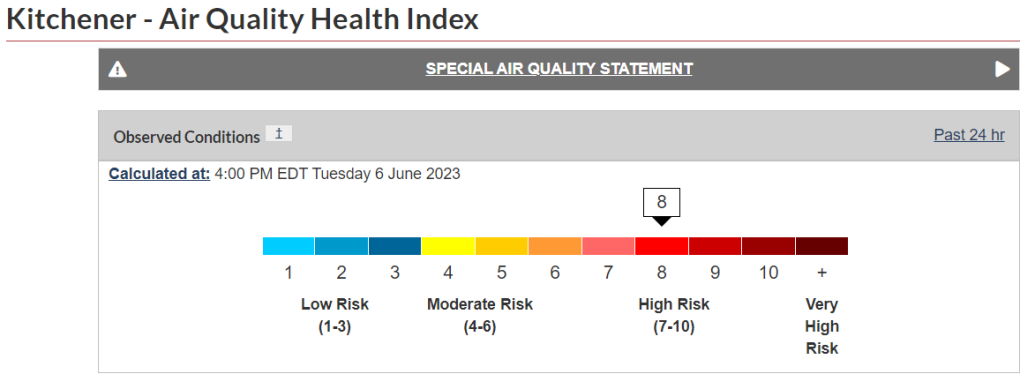 The Air Quality Health Index for Kitchener was changed to a level eight, or high-risk, on Tuesday afternoon. (Environment Canada)
The Air Quality Health Index for Kitchener was changed to a level eight, or high-risk, on Tuesday afternoon. (Environment Canada)
Vaswani said there are three different pollutants that contribute to air quality values.
One of them is PM2.5 – or particulate matter.
“That’s basically the pollutant that we’re worried about from forest fires, even though right now Kitchener-Waterloo doesn’t have particularly bad air quality according to the current observations, there is the potential for that to change depending on, for example, if we get a plume of smoke coming in from the northeast,” Vaswani said.
Canada’s Wildfire Smoke Prediction System (FireWork) animation map shows the average PM2.5 level is expected to get worse over the next three days.
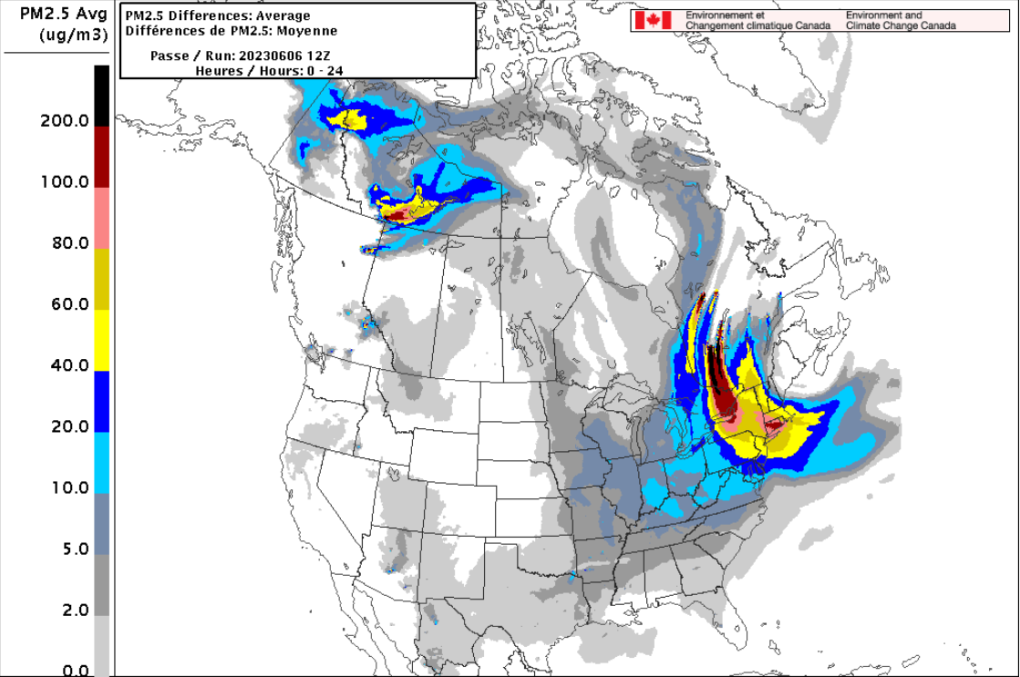 The average PM2.5 at ground level in Ontario. (Environment Canada)
The average PM2.5 at ground level in Ontario. (Environment Canada)
“The FireWork system makes it possible to include the effects of wildfire smoke in forecasts of air quality by estimating the amount of pollution that will be added to the air. These smoke forecast maps show how the air quality in your community may be affected by wildfire smoke,” the national weather agency’s website reads.
Vaswani said the winds coming from the northeast are expected to continue bringing in that plume of smoke – which is currently already over K-W and the Greater Toronto Area.
“The question is, how much of that [the plume] will make its way to the surface,” Vaswani said.
According to Vaswani, people smelling smoke means it is already making its way down to the surface in some communities.
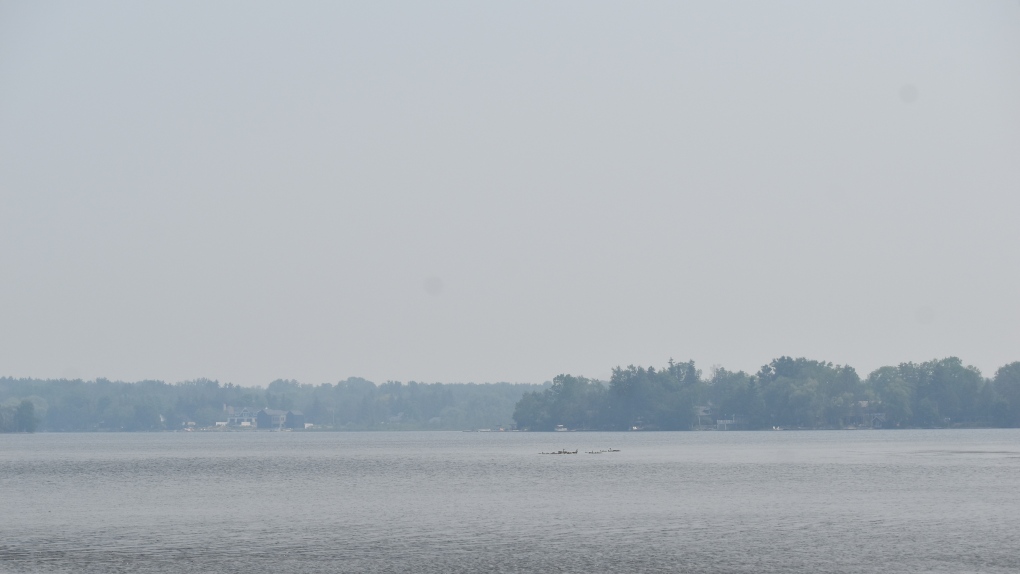 Hazy smoke hovering over Puslinch Lake on June 6, 2023. (Submitted)
Hazy smoke hovering over Puslinch Lake on June 6, 2023. (Submitted)
She said the PM 2.5 values start to become a concern once they reach 60.
“For Kitchener earlier today, it did get as high as 47, but it is starting to level out,” Vaswan said.
She said the values reached just over 100 on Sunday, and these figures can vary throughout the day due to winds.
PLANS CHANGE AS AIR QUALITY DETERIORATES
“I wasn’t happy to get out, but the kids like to come to the park and play,” Ferhad Mustafa said while out enjoying Victoria Park in Kitchener.
He said he is sure he will return to the park this week as air quality deteriorates.
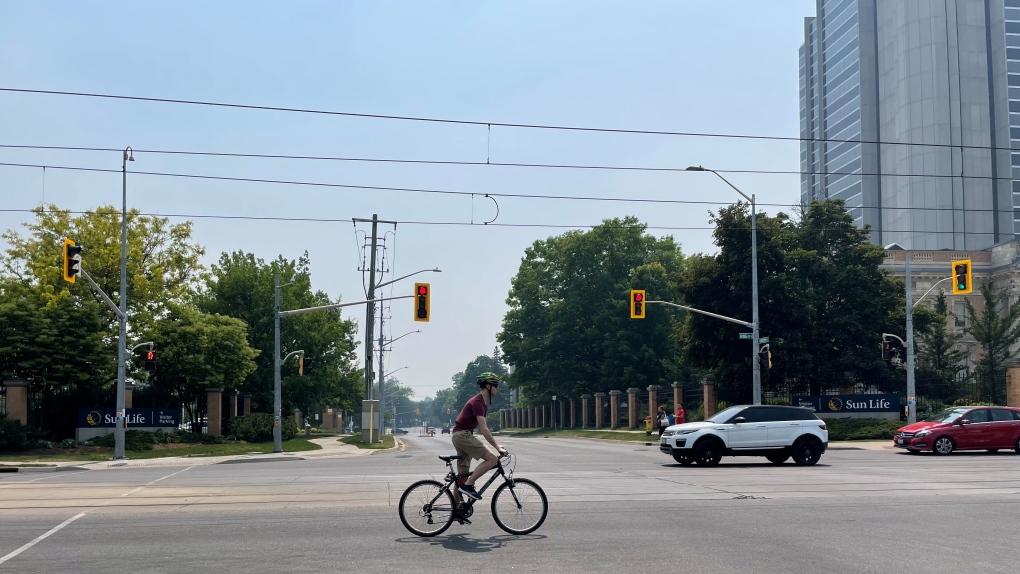 Haze from wildfires burning in northeastern Ontario and Quebec can be seen in Waterloo on June 6, 2023. (Alison Sandstrom/CTV News)
Haze from wildfires burning in northeastern Ontario and Quebec can be seen in Waterloo on June 6, 2023. (Alison Sandstrom/CTV News)
“It’s important to stay home if it gets worse because it would not be healthy for the kids and even for us too,” Ferhad added.
Another resident said they were considering changing plans to spend more time indoors.
“I think we were going to spend a little bit longer outside, but now that it’s a bit smoky we might spend a bit more time inside today,” Oliver Bullingham said while outside.
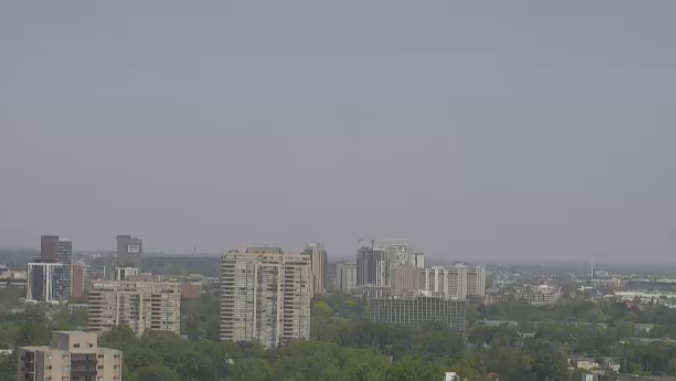 The view from the CTV News Kitchener tower on Tuesday, June 6 shows a haze over the skyline in Waterloo region as wildfires burn in northeastern Ontario and Quebec. (CTV)
The view from the CTV News Kitchener tower on Tuesday, June 6 shows a haze over the skyline in Waterloo region as wildfires burn in northeastern Ontario and Quebec. (CTV)
Others say they are thinking about Environment Canada’s advice to wear a mask while out and about.
“If I knew it coming in, I definitely would have taken a mask,” Ryan Flynn said while speaking about the air quality.
Meanwhile, Isabella Wilson said if she was aware of the advisory she may have changed her plans for the day.
“I was unaware of the advisory, so if I would have known then perhaps I would have changed our plans for today,” Wilson said.
HEALTH CONCERNS AN ISSUE
The deteriorating air quality can also pose a health risk, especially for people considered high-risk, including those with lung diseases such as asthma or heart disease, older adults, children, pregnant people, and people who work outdoors are at higher risk of experiencing health effects caused by wildfire smoke.
Vaswani said those who fall into this vulnerable population will want to stay indoors and limit their outdoor exposure.
She recommends shutting windows and using an air purifier with a HEPA filter.
If you must spend time outdoors, Environment Canada recommends a well-fitted respirator-type mask that does not allow air to pass through small openings between the mask and face. This type of mask can help reduce your exposure to the fine particles in smoke.
The agency also said to stop outdoor activities and contact your health care provider if you or someone in your care experiences shortness of breath, wheezing, severe cough, dizziness or chest pains.
The Lung Health Foundation says keeping indoor air clean with filters can make a difference.
“Keeping your windows and doors closed as much as possible. There are HEPA filters that you can get for your indoor air quality,” Jessica Buckley, president & chief executive officer of the Lung Health Foundation said.
Adding: “We also recommend when people are travelling in their car, to keep their windows closed as well and use the circulator so the air inside the car is circulating versus the air from the outside.”
The Lung Health Foundation has a free helpline people can call and email that will answer anyone’s questions about symptoms.
The foundation can be reached at info@lunghealth.ca from Monday to Thursday from 9 a.m. to 4 p.m. and on Friday from 9 a.m. to 12 p.m.
CTVNews.ca Top Stories

Bird flu, measles top 2025 concerns for Canada's chief public health officer
As we enter 2025, Dr. Theresa Tam has her eye on H5N1 bird flu, an emerging virus that had its first human case in Canada this year.
Azerbaijan observes day of mourning for air crash victims as speculation mount about its cause
Azerbaijan on Thursday observed a nationwide day of mourning for the victims of the plane crash that killed 38 people and left all 29 survivors injured as speculation mounted about a possible cause of the disaster, with some experts saying that the airliner was damaged by Russian air defence fire.
6,000 inmates stage Christmas Day escape from high-security Mozambique prison
At least 6,000 inmates escaped from a high-security prison in Mozambique's capital on Christmas Day after a rebellion, the country's police chief said, as widespread post-election riots and violence continue to engulf the country.
Christmas shooting at Phoenix airport leaves 3 people wounded
Police are investigating a Christmas shooting at Sky Harbor Airport in Phoenix that left three people injured by gunfire.
Working Well: Returning to the office can disrupt life. Here are some tips to navigate the changes
Heading into 2025, thousands of workers face an unsettling reality: after years of working from the comfort of home, they must return to the office full-time for the first time since the coronavirus pandemic or look for new work.
Donald Trump says he urged Wayne Gretzky to run for prime minister in Christmas visit
U.S. president-elect Donald Trump says he told Canadian hockey legend Wayne Gretzky he should run for prime minister during a Christmas visit but adds that the athlete declined interest in politics.
New York taxi driver hits 6 pedestrians, 3 taken to hospital, police say
A taxicab hit six pedestrians in midtown Manhattan on Wednesday, police said, with three people — including a 9-year-old boy — transported to hospitals for their injuries.
Prayers and tears mark 20 years since the Indian Ocean tsunami that killed some 230,000 people
People gathered in prayer and visited mass graves in Indonesia’s Aceh province on Thursday to mark 20 years since the massive Indian Ocean tsunami hit the region in one of modern history’s worst natural disasters.
Historical mysteries solved by science in 2024
This year, scientists were able to pull back the curtain on mysteries surrounding figures across history, both known and unknown, to reveal more about their unique stories.

































